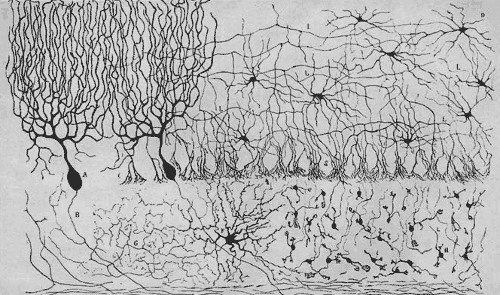This week, Professor Vesna talked about the neuroscience and
its intersection with art. In the lecture video, Professor Vesna mentions about
Santiago Ramon y Cajal, who is regarded as “founder of neuroanatomy.” He is the
one who made a great contribution to the understanding of the microscopic
nature of the nervous system and his drawing of neurons have been used to help
people to better understand the structure and complexities of the brain and I
believe this can be considered as one of the first example of intersection of art
and neuroscience.

In lecture video, professor talks about how Cajal referred
to neurons as the “mysterious butterflies of the soul” and this reminds me of
Giovanni Frazzetto and Suzanne Anker’s article “Neuroculture.” This article
mentions one of Suzanne Anker’s work, fMRI Butterfly, and in this work, 15
identical brain scans are arranged in grid and at the center of each brain
scan, there is an image of butterfly with a different patterns of ink blots.
Identical butterflies are placed on the center of each grid, but variations of
inkblots in each frame causes “viewer subtle optical illusions” as if each
frame has different butterflies. This is a really nice example of collaboration
of neuroscience and art. It is so fascinating that artist used identical brain
scans and butterflies and can still give different nuance in each frame by just
having different patterns of ink blots. I am so surprised how she could even
come up with this idea. I think I found Anker’s “fMRI Butterfly” more
fascinating than the works of other artists, because to me, she used really
basic materials, brain scans, to give me awe.


I personally do not have any experience with neuroscience
and am not very familiar with the materials related to neuroscience. So, when I
first saw the topic for this week, I was totally lost and wasn’t sure how artists
can incorporate neuroscience in their work. I really appreciate reading the
article “Neuroculture” and get to know about Anker’s “fMRI Butterfly” and also
I really liked the “dream” part of the lecture. It makes so much sense now, but
before today I never relate dreams to neuroscience. As a person who dreams a
lot, it was interesting to me that “dream” can be the inspiration for some
artists.
Resources:
Anker, Suzanne. MRI Butterfly (3). Digital image. N.p., 2008. Web. 21 May 2017. <http://suzanneanker.com/artwork/?wppa-album=16&wppa-photo=127&wppa-occur=1>
Anker, Suzanne. MRI Butterfly. Digital image. N.p., 2008. Web. 21 May 2017. <http://suzanneanker.com/artwork/?wppa-album=16&wppa-photo=152&wppa-occur=1>
Frazzetto, Giovanni, and Suzanne Anker. "Neuroculture." Nature Reviews Neuroscience Nat Rev Neurosci.10.11(2009):815-21. Web. 21 My 2017.
"Santiago Ramon y Cajal." Famous Scientists. n.p., n.d. web. 21 May 2017. <https://www.famousscientists.org/santiago-ramon-y-cajal/>
Vesna, Victoria. “Neuroscience-pt1.mov.” YouTube. YouTube, 17 May 2012. Web. 21 May 2017. <https://www.youtube.com/watch?v=TzXjNbKDkYI>
Vesna, Victoria. “Neuroscience-pt2.mov.” YouTube. YouTube, 17 May 2012. Web. 21 May 2017. <https://www.youtube.com/watch?v=TFv4owX3MZo>
Comments
Post a Comment